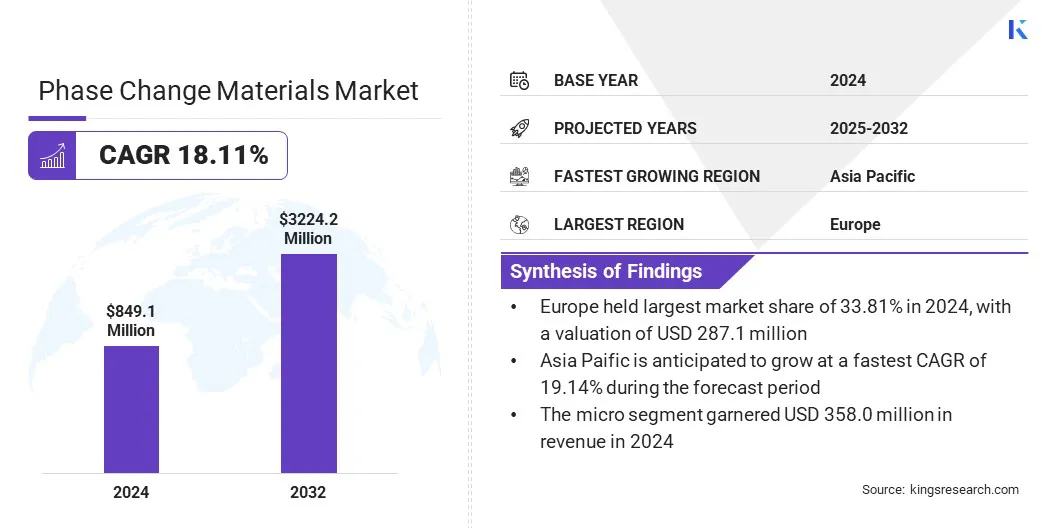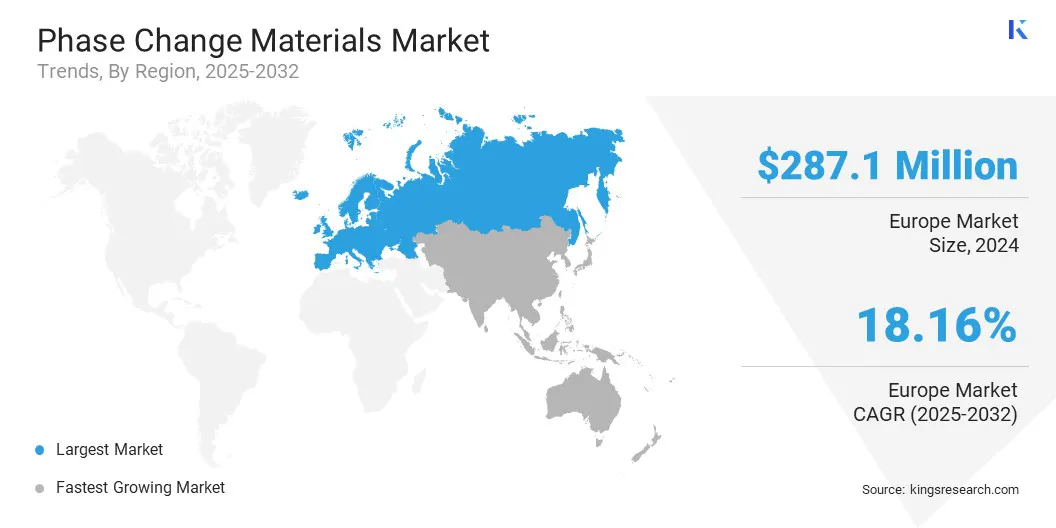Market Definition
A phase change material (PCM) is a substance that absorbs and releases thermal energy by changing its physical state, typically between solid and liquid. PCMs absorb heat as they melt and release it as they solidify, making them highly effective for thermal energy storage and temperature regulation.
The market involves the production, innovation, and application of PCMs across industries such as construction, cold chain packaging, textiles, electronics, and automotive.
The report explores key drivers of market development, offering detailed regional analysis and a comprehensive overview of the competitive landscape shaping future opportunities.
Phase Change Materials Market Overview
According to Kings Research, global phase change materials market size was valued at USD 849.1 million in 2024, which is estimated to be valued at USD 1,001.4 million in 2025 and reach USD 3,224.2 million by 2032, growing at a CAGR of 18.11% from 2025 to 2032.
This growth is primarily driven by the increasing need to reduce energy consumption for heating and cooling in buildings. Phase change materials (PCMs) enhance thermal regulation and help lower utility costs, making them an attractive solution in energy-efficient building construction, HVAC systems, and temperature-sensitive storage applications.
Key Market Highlights:
- The phase change materials industry size was recorded at USD 849.1 million in 2024.
- The market is projected to grow at a CAGR of 18.11% from 2025 to 2032.
- Europe held a market share of 33.81% in 2024, with a valuation of USD 287.1 million.
- The organic segment garnered USD 326.5 million in revenue in 2024.
- The micro segment is expected to reach USD 1345.3 million by 2032.
- The cold chain & packaging segment is anticipated to witness the fastest CAGR of 18.27% during the forecast period
- Asia Pacific is anticipated to grow at a CAGR of 19.14% during the forecast period.
Major companies operating in the phase change materials market are Honeywell International Inc., Boyd, Polymer Science, Inc., Sasol Limited, Croda International Plc, PCM Products Ltd, AXIOTHERM GmbH, CAVU Group, Outlast Technologies GmbH, Pluss Advanced Technologies, Phase Change Products Pty Ltd, PureTemp LLC, Rubitherm Technologies GmbH, Henkel Corporation, and Laird Technologies, Inc.

The market is experiencing steady growth, driven by increasing demand for energy-efficient and sustainable thermal management solutions. PCMs are used across various sectors including building and construction, electronics, textiles, packaging, and automotive, where temperature regulation is critical.
Market expansion is supported by advancements in material science, growing emphasis on renewable energy integration, and stringent environmental regulations. Innovations in nanotechnology and encapsulation techniques are further enhancing PCM performance, making them increasingly viable for commercial and industrial applications.
- In July 2024, researchers at the University of California, Berkeley, introduced advanced nanoscale imaging techniques to study ultrafast carrier dynamics in nanomaterials, including phase change materials. By applying near-field transient nanoscopy, the team examined exciton behavior in two-dimensional materials and analyzed phase transitions in vanadium dioxide (VO₂), a material known for its ability to shift between insulating and metallic states.
Rising Demand for Energy Efficiency
Rising energy demands for heating and cooling in both residential and commercial buildings have intensified the need for sustainable thermal management solutions.
Phase Change Materials (PCMs) present a viable strategy by efficiently storing and releasing latent heat during phase transitions, thereby reducing the dependence on conventional HVAC systems. This not only contributes to substantial energy conservation and operational cost savings but also aligns with global efforts toward enhanced energy efficiency and decarbonization.
Consequently, the integration of PCMs in building insulation and envelope systems is witnessing increased adoption, driving market growth and technological advancement in the market.
- In March 2023, researchers from Purdue University developed a novel, scalable method to incorporate phase change materials (PCMs) into construction materials. This process enhances thermal inertia and strength while reducing energy use and emissions. The innovation aims to improve building energy efficiency, comfort, and resilience by optimizing PCM performance in building envelopes.
Material Stability and Longevity
A key challenge in the phase change materials market is material stability, as some PCMs degrade or lose effectiveness after repeated phase transitions, reducing their long-term performance. This degradation can limit product lifespan and reliability, hindering broader adoption.
To address this, companies and researchers are developing more stable PCM formulations and advanced encapsulation techniques that protect the material from thermal and chemical breakdown. These innovations enhance durability, ensuring consistent thermal performance and extending the usable life of PCM-based products.
Focus on Elemental Models
The market is witnessing a growing trend toward using elemental models to better understand and optimize PCM behavior. Elemental models are simplified materials composed of a single type of atom, used to study fundamental properties.
These models allow researchers to analyze atomic bonding and phase transitions more clearly, leading to improved material design. This approach accelerates the development of efficient, durable PCMs for applications in data storage, thermoelectrics, and energy management.
- In January 2025, researchers from Leipzig University, RWTH Aachen University, and DESY Hamburg studied antimony—an elemental metalloid with distinct bonding characteristics. Their findings demonstrated a gradual transition from classical covalent to electron-rich multi-center bonding. By using antimony as a model system, the research provides valuable insights for optimizing the phase transition behavior of PCMs, contributing to more advanced and efficient materials for next-generation technologies.
Phase Change Materials Market Report Snapshot
|
Segmentation
|
Details
|
|
By Type
|
Organic, Inorganic, Eutectic
|
|
By Encapsulation
|
Micro, Nano, Macro
|
|
By Application
|
Building & Construction, HVAC, Cold Chain & Packaging, Thermal Energy Storage, Textile, Electronics, Others
|
|
By Region
|
North America: U.S., Canada, Mexico
|
|
Europe: France, UK, Spain, Germany, Italy, Russia, Rest of Europe
|
|
Asia-Pacific: China, Japan, India, Australia, ASEAN, South Korea, Rest of Asia-Pacific
|
|
Middle East & Africa: Turkey, U.A.E., Saudi Arabia, South Africa, Rest of Middle East & Africa
|
|
South America: Brazil, Argentina, Rest of South America
|
Market Segmentation:
- By Type (Organic, Inorganic, and Eutectic): The organic segment earned USD 326.5 million in 2024, driven by its superior thermal stability, non-corrosiveness, and eco-friendliness, making it ideal for various temperature control applications.
- By Encapsulation (Micro, Nano, and Macro): The micro segment held 42.17% of the market in 2024, due to its ability to prevent PCM leakage, enhance thermal performance, and integrate seamlessly into construction and textile materials.
- By Application (Building & Construction, HVAC, Cold Chain & Packaging, Thermal Energy Storage, Textile, Electronics, and Others): The building & construction segment is projected to reach USD 783.2 million by 2032, owing to the rising demand for energy-efficient buildings and the integration of PCMs into insulation and wall systems.
Phase Change Materials Market Regional Analysis
Based on region, the global market has been classified into North America, Europe, Asia Pacific, Middle East & Africa, and South America.

Europe phase change materials market share stood at 33.81% in 2024 in the global market, with a valuation of USD 287.1 million. Europe leads the global market due to its commitment to sustainability, energy efficiency regulations, and significant investments in green technologies.
The region’s proactive policies in building insulation, renewable energy integration, and environmentally friendly manufacturing practices drive high demand for PCMs.
Additionally, Europe’s well-established industrial base and focus on innovation boost rapid adoption and development of advanced thermal management solutions, driving the PCM market across the region.
- In December 2023, First Series partnered with Phase Change Solutions to distribute BioPCM-based Apollo Panels in the UK. The panels aim to reduce refrigeration energy use and medicine waste, supporting sustainable thermal management and aligning with the UK’s efforts to enhance energy efficiency in healthcare infrastructure.
Asia Pacific is poised for significant growth at a robust CAGR of 19.14% over the forecast period. This growth is driven by rapid industrialization, ongoing urban development, and a rising focus on energy-efficient technologies.
Countries such as China, India, and Japan are making substantial investments in sustainable construction, which is boosting demand for phase change materials used in insulation and temperature regulation across residential, commercial, and industrial buildings.
Additionally, the expanding electronics and automotive sectors in the region are increasingly adopting phase change materials (PCMs) for effective thermal management, further driving market growth through enhanced energy efficiency and component protection.
Government support for green initiatives and rising awareness of energy conservation is further accelerating market growth across Asia Pacific.
Regulatory Frameworks
- In the U.S., the EPA’s Green Building Program promotes sustainable building materials, driving demand for eco-friendly construction practices.
- In the EU, the revised Energy Performance of Buildings Directive (EU/2024/1275) and Energy Efficiency Directive (EU/2023/1791) focus on improving building energy efficiency, fostering decarbonization, and ensuring a stable investment framework, pushing the adoption of efficient materials.
- In India, the National Building Code (NBC) establishes comprehensive guidelines that prioritize safety, sustainability, and energy efficiency in construction, promoting the use of advanced technologies.
Competitive Landscape
Companies in the phase change materials market are actively forming strategic partnerships, investing in innovative technologies, and expanding their product portfolios to meet growing demand for energy-efficient and sustainable solutions.
They focus on developing advanced PCM-based products that enhance thermal management across various sectors, including construction, healthcare, and logistics.
Additionally, firms are emphasizing retrofitting existing infrastructure and improving material performance to reduce carbon footprints, energy consumption, and operational costs, thereby supporting global sustainability and carbon neutrality goals.
- In May 2023, DIC Corporation partnered with Phase Change Solutions Inc. to commercialize BioPCM phase change materials in Japan’s infrastructure sector. These materials reduce air-conditioning energy use by 15-30%, lowering carbon emissions in office buildings and telecom shelters. The collaboration supports Japan’s carbon-neutral goals by promoting advanced thermal management solutions and retrofitting existing facilities with sustainable technology.
Key Companies in Phase Change Materials Market:
- Honeywell International Inc.
- Boyd
- Polymer Science, Inc.
- Sasol Limited
- Croda International Plc
- PCM Products Ltd
- AXIOTHERM GmbH
- CAVU Group
- Outlast Technologies GmbH
- Pluss Advanced Technologies
- Phase Change Products Pty Ltd
- PureTemp LLC
- Rubitherm Technologies GmbH
- Henkel Corporation
- Laird Technologies, Inc
Recent Developments (Partnership/Product Launch)
- In December 2023, Tessol partnered with Phase Change Solutions to introduce BioPCM-based products in India. The collaboration focuses on cold chain applications in the food and pharmaceutical sectors. These products aim to enhance temperature stability, lower carbon emissions, and reduce spoilage through the use of eco-friendly phase change materials.
- In May 2023, Henkel launched Bergquist Hi Flow THF 5000UT, a phase change thermal interface material designed for high-power devices. It offers low thermal resistance, reliable performance at ultra-low pressure, and simplifies application while enhancing heat dissipation in complex IC designs.


